Posture & Torso Alignment (PTA) System
The TheraTogs Posture & Torso Alignment (PTA) System is the preferred starting point for seeing improvements in upper body alignment and posture by providing carryover of rehabilitation activities that take advantage of our neuromotor system’s ability to learn and adapt to corrected alignment.
How to Purchase TheraTogs
Clinicians:
Login/Signup to the professionals-only side of the website for ordering options.
Caregivers:
Paying out-of-pocket? Consult with your therapist or rehab clinician to place an order with an authorized TheraTogs distributor.
Seeking reimbursement? Most payors require the order be processed via an O&P provider or DME (Durable Medical Equipment) facility. Find a Provider near you who is familiar with TheraTogs, or have your preferred Provider contact us for assistance in ordering.
Need help with size, selection, or ordering? Contact Customer Support: [email protected] • (970) 239-0344. For sizing guidance, see the Sizing tab below.
Indications & Applications
The PTA can provide hours of carryover in addressing:
- Hypotonia
- Flexible kyphosis
- Flexible lordosis / excessive pelvic tilt
- Difficulty maintaining midline trunk and sitting balance
- Weak trunk muscles
- Shoulder protraction & scapular abduction
Quick Links
Our Postural Alignment Algorithm will help clinicians determine their best options in managing postural alignment.
Description
TheraTogs Posture & Torso Alignment (PTA) System is the preferred starting point for seeing improvements in upper body alignment and posture by using outside-the-clinic carryover to take advantage of our neuromotor system’s ability to learn and adapt to corrected alignment.
The PTA system consists of two garments and a small set of straps – a basic TheraTogs system that’s simple to apply, cost-effective, and easy to learn how to use.
Leverages the human “upright” response to improved functional alignment
The PTA System includes the same TankTop and Hipster as the Full Body System, and is a good introduction to working with and using TheraTogs because you can see immediate results. The PTA system is simple to use, it only takes a few minutes to put on, and it gives the wearer all-day-long carryover of the postural and torso retraining she or he received in-clinic.
By focusing on trunk stability and postural alignment, you’ll lay the foundation for even more advanced outcomes.
Research
For rehab clinicians, the relevance of postural control is significant, particularly during infant and toddler development.
Postural control:
- Develops to sustain life and to optimize attention and to support learning and function.
- Provides the stability needed to liberate the limbs and head to explore and move.
- Acquisition begins at the head and neck and progresses to the toes.
- Acquisition begins with extension of the neck and trunk muscles against gravity, soon balanced by neck and trunk flexion.
- Deficits have been identified as a significant concern in children with cerebral palsy.
- The reliance on the tonic recruitment of limb muscles to compensate for a core stability deficit has not yet been investigated.
These references all speak to the importance of proper trunk alignment – the explicit purpose of the TheraTogs PTA System:
Babik I, Galloway JC, Lobo MA. 2017. Infants born preterm demonstrate impaired exploration of their bodies and surfaces throughout the first 2 years of life. Phys Ther. 97(9):915-925.
Bly L. 2011. Components of Typical and Atypical Motor Development. Neurodevelopmental Treatment Association; www.ndta.org
Boxum AG, van Balen LC, Dijkstra LJ, et al. 2014. Postural adjustments in infants at very high risk for cerebral palsy before and after developing the ability to sit independently. Early Hum Dev. 90(9):435-41.
Brogren E, Hadders-Algra M, Forssberg H. 1998. Postural control in sitting children with cerebral palsy. Neurosci Biobehav Rev. 22(4):591-6. Review.
de Graaf-Peters VB, Blauw-Hospers CH, Dirks T, et al. 2007. Development of postural control in typically developing children and children with cerebral palsy: possibilities for intervention? Neurosci Biobehav Rev. 31(8):1191-2000. Review.
Dudek-Shriber L, Zelazny S. 2007. The effects of prone positioning on the quality and acquisition of developmental milestones in four-month-old infants. Pediatr Phys Ther. 19(1):48-55.
Dusing SC, Harbourne RT, Lobo MA, et al. 2019. a physical therapy intervention to advance cognitive and motor skills: a single subject study of a young child with cerebral palsy. Pediatr Phys Ther. 31(4):347-352.
Dusing SC, Izzo TA, Thacker LR, Galloway JC. 2014. Postural complexity differs between infant born full term and preterm during the development of early behaviors. Early Hum Dev. 90(3):149-56. Free PMC article.
Dusing SC, Thacker LR, Galloway JC. 2016. Infant born preterm have delayed development of adaptive postural control in the first 5 months of life. Infant Behav Dev. 44:49-58.
Feldman AG. 2016. The Relationship Between Postural and Movement Stability. Adv Exp Med Biol. 957:105-120. Review.
Gramsbergen A, Hadders-Algra M. 2005. Posture in the picture: on the relevance of postural control in children with developmental motor disorders. Summer, 2004. Groningen, The Netherlands. Neural Plast. 12(2-3):73-75. Free PMC article.
Green EM, Mulcahy CM, Pountney TE. 1995. An investigation into the development of early postural control. Dev Med Child Neurol. 37(5):437-48.
Hadders-Algra M, Brogren E, Forssberg H. 1998. Development of postural control–differences between ventral and dorsal muscles? Neurosci Biobehav Rev. 22(4):501-6. Review.
Hadders-Algra M, Carlberg EB. 2008. Postural Control: A Key Issue in Developmental Disorders (Clinics in Developmental Medicine), MacKieth Press (Wiley).
Hadders-Algra M. Neurosci Biobehav Rev. 2018. Early human motor development: From variation to the ability to vary and adapt. 90:411-427. Free article. Review.
Heathcock JC, Galloway JC. 2009. Exploring objects with feet advances movement in infants born preterm: a randomized controlled trial. Phys Ther. 89(10):1027-38. Free PMC article. Clinical Trial.
Hirabayashi S, Iwasaki Y. 1995. Developmental perspective of sensory organization on postural control. Brain Dev. 17(2):111-3.
Johnston MV. 2009. Plasticity in the developing brain: implications for rehabilitation. Dev Disabil Res Rev. 15(2):94-101.
Konishi Y, Takaya R, Kimura K, et al. 1994. Development of posture in prone and supine positions during the prenatal period in low risk preterm infants. Arch Dis Child Fetal Neonatal Ed. 70(3):F188-91. Free PMC article.
Lee HM, Galloway JC. 2012. Early intensive postural and movement training advances head control in very young infants. Phys Ther. 92(7):935-47. Clinical Trial.
Lobo MA, Kokkoni E, Cunha AB, Galloway JC. Infants born preterm demonstrate impaired object exploration behaviors throughout infancy and toddlerhood. Phys Ther. 2015;95(1):51-64.
Monterosso L, Kristjanson L, Cole J. 2002. Neuromotor development and the physiologic effects of positioning in very low birth weight infants. J Obstet Gynecol Neonatal Nurs. 31(2):138-46. Review.
Rocha NA, dos Santos Silva FP, de Toledo AM, Tudella E. 2009. Variability in the levels of postural control in 0-4-month-old infants. Infant Behav Dev. 32(4):376-80.
Rocha NA, Tudella E. 2008. The influence of lying positions and postural control on hand-mouth and hand-hand behaviors in 0-4-month-old infants. Infant Behav Dev. 31(1):107-14.
Steindl R, Kunz K, Schrott-Fischer A, Scholtz AW. 2006. Effect of age and sex on maturation of sensory systems and balance control. Dev Med Child Neurol. 48(6):477-82.
Sweeney JK, Gutierrez T. 2002. Musculoskeletal implications of preterm infant positioning in the NICU. J Perinat Neonatal Nurs. 16(1):58-70.Review.
Vaivre-Douret L, Ennouri K, Jrad I, Garrec C, Papiernik E. 2004. Effect of positioning on the incidence of abnormalities of muscle tone in low-risk, preterm infants. Eur J Paediatr Neurol. 8(1):21-34. Clinical Trial.
van Balen LC, Dijkstra LJ, Dirks T, Bos AF, Hadders-Algra M. 2019. Early Intervention and Postural Adjustments During Reaching in Infants at Risk of Cerebral Palsy. Pediatr Phys Ther. 31(2):175-183.
van Balen LC, Boxum AG, Dijkstra LJ, et al. 2018. Are postural adjustments during reaching related to walking development in typically developing infants and infants at risk of cerebral palsy? Infant Behav Dev. 50:107-115.
Product Properties
TheraTogs systems are FDA Class I medical devices intended to be issued by, and applied under the supervision of, a licensed healthcare practitioner engaged in neuromotor training. TheraTogs systems are made of GoldTone – a proprietary composite fabric with foam backing made of an aqueous-based elastomeric urethane. TogRite strapping is elastomeric strapping with an inert, silicone-based grip surface. All materials and components of TheraTogs™ orthotic garment systems are latex-free in their manufacture and packaging.
TheraTogs™, Therapy You Wear™, TogRite™ and Wunzi™ are trademarks of TheraTogs, Inc. TheraTogs systems are protected by US Patents # 8,007,457 and 8,535,256 B2. Additional US and foreign patents pending.
Only logged in customers who have purchased this product may leave a review.

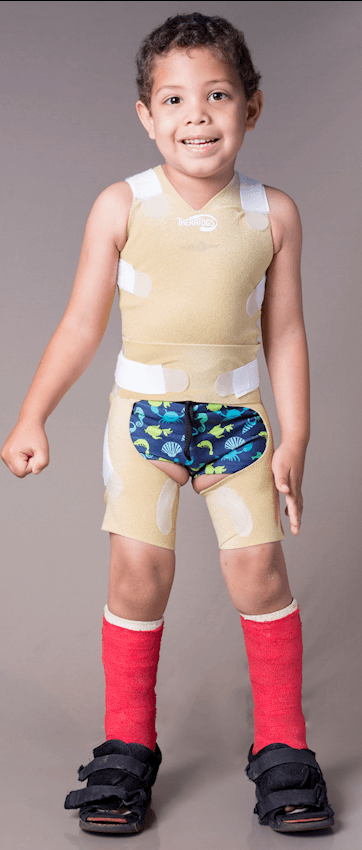
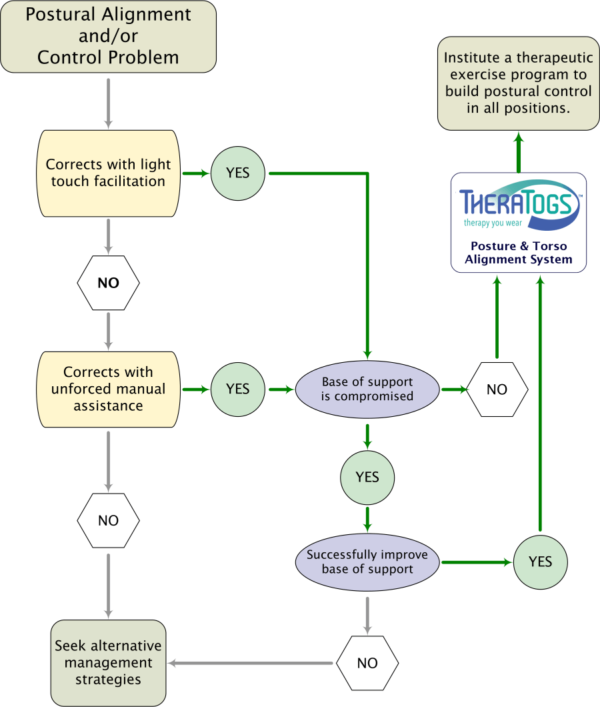
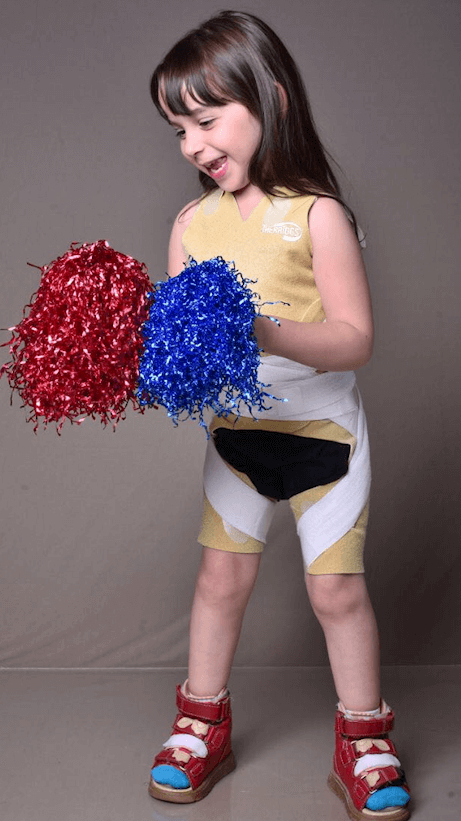

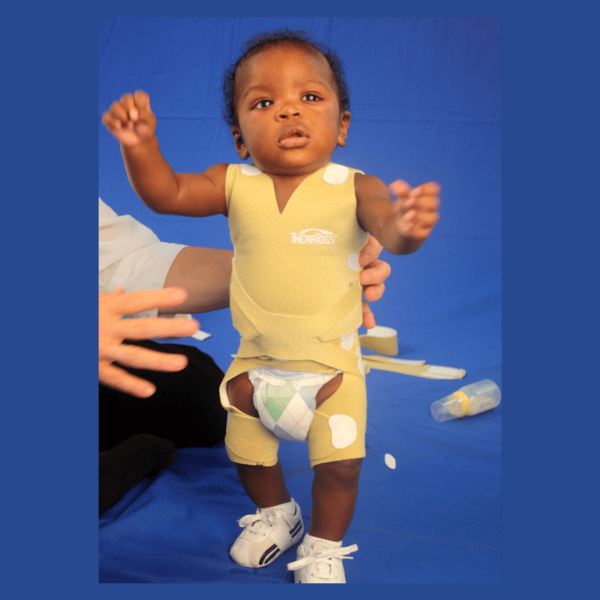
















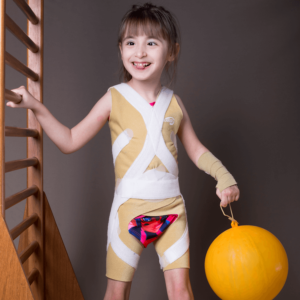


Reviews
There are no reviews yet.